PREHISTORIC
REIMAINS
STATUES
AND CROWNS
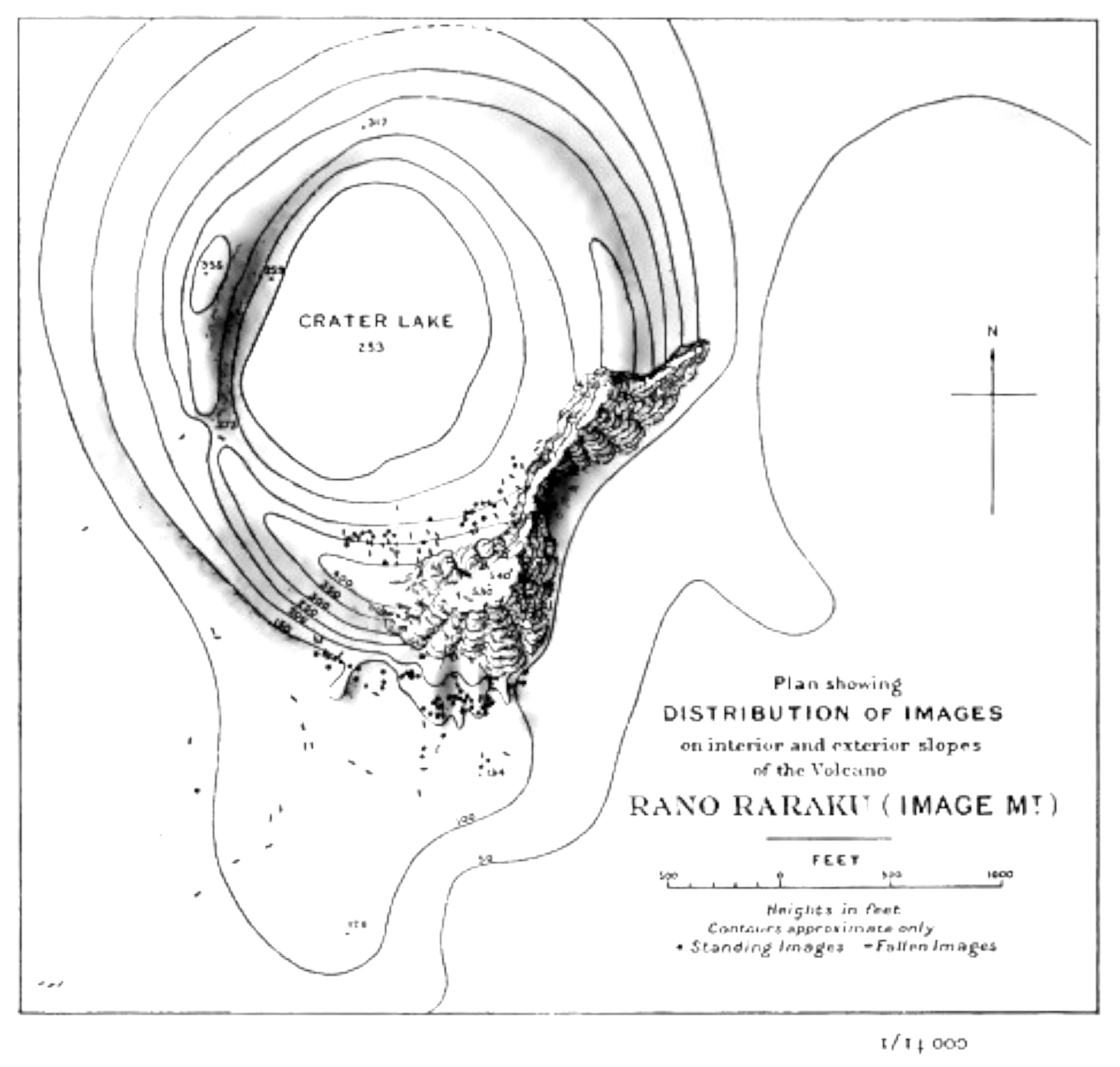 FIG 44.
FIG 44.
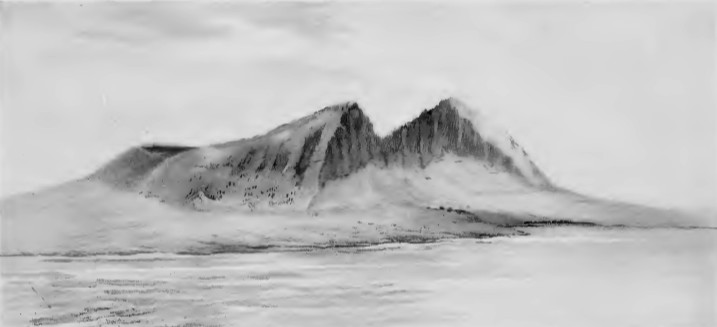 FIG 45. — RANO
RARAKU FROM THE SEA
FIG 45. — RANO
RARAKU FROM THE SEA

FIG 46. — RANO RARAKU
FROM THE SOUTH-WEST
Images prostrate in foreground and erect on slope; quarries above.
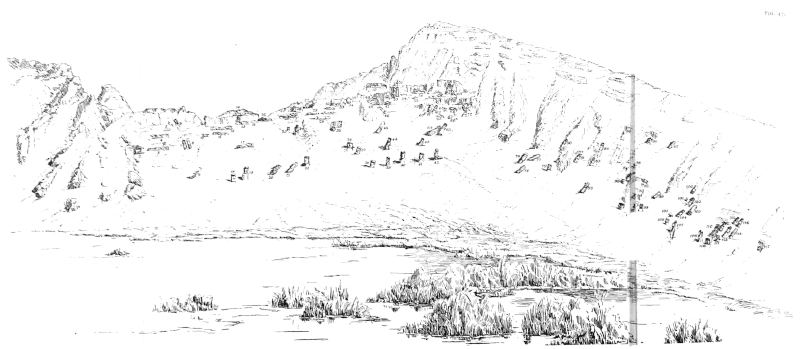
FIG. 47. — RANO RARAKU INTERIOR OF
CRATER
Diagrammatic sketch showing position of statues on slope and in quarry.
CHAPTER
XIV
PREHISTORIC
REIMAINS [continued)
STATUES
AND CROWNS
Rano
Raraku, its Quarries and Standing Statues — the South-east Face of the
Mountain
— Isolated Statues — Roads — Stone Crowns of the Images.
Strange
as it may appear, it is by no means easy to obtain a complete view of a
statue
on the island: most of the images which were formerly on the ahu lie on
their
faces, many are broken, and detail has largely been destroyed by
weather.
Happily, we are not dependent for our knowledge of the images on such
information as we can gather from the ruins on the ahu, but are able to
trace
them to their origin, though even here excavation is necessary to see
the
entire figure. Rano Raraku is, as has already been explained, a
volcanic cone
containing a crater-lake. It resembles, to use an unromantic simile,
one of the
china drinking-vessels dedicated to the use of dogs, whose base is
larger than
their brim. Its sides are for the most part smooth and sloping, and
several
carriages could drive abreast on the northern rim of the crater, but
towards
the south-east it rises in height, and from this aspect it looks as if
the
circular mass had been sliced do^\^l with a giant knife forming it into
a
precipitous cliff. The cliff is lowest where the imaginary knife has
come
nearest to the central lake, thus causing the two ends to stand out as
the
peaks already mentioned (fig. 45).
The
mountain is composed of compressed volcanic ash, which has been found
in
certain places to be particularly suitable for quarrying; it has been
worked on
the southern exterior slope, and also inside the crater both on the
south and south-eastern
sides. With perhaps a dozen exceptions, the whole of the images in the
island
have been made from it, and they have been dragged from this point up
hill and
down dale to adorn the terraces round the coast-line of the island;
even the
images on the ahu, which have fallen into the sea on the further
extremity of
the western volcano, are said to have been of the same stone. It is
conspicuous
in being a reddish brown colour, of which the smallest chips can be
easily
recognised. It is composite in character, and embedded in the ash are
numerous
lapilli of metamorphic rock. Owing to the nature of this rock the
earliest
European visitors came to the conclusion that the material was
factitious and
that the statues were built of clay and stones; it was curious to find
that the
marooned prisoners of war of our own time fell into the same mistake of
thinking
that the figures were "made up."
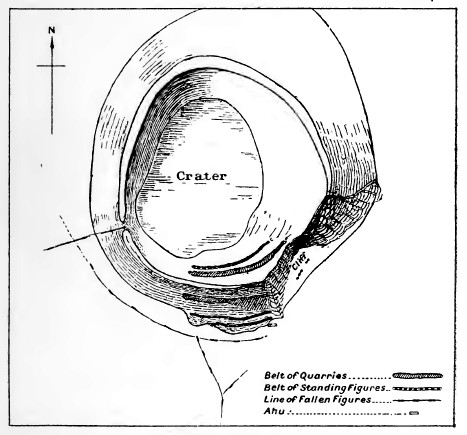 FIG. 48. — Diagram
of Rang Raraku.
FIG. 48. — Diagram
of Rang Raraku.
The
workable belt, generally speaking, forms a horizontal section about
half-way up
the side of the mountain. Below it, both on the exterior and within the
crater,
are banks of detritus, and on these statues have been set up; most of
them are
still in place, but they have been buried in greater or less degree by
the
descent of earth from above (fig. 57). Mr. Ritchie made a survey of the
mountain with the adjacent coast, but it was found impossible to record
the
results of our work without some sort of plan or diagram which was
large enough
to show every individual image. This was accomplished by first studying
each
quarry, note-book in hand, and then, with the aid of field-glasses,
amalgamating the results from below; the standing statues being
inserted in
their relation to the quarries above. It was a lengthy but enjoyable
undertaking.
Part of the diagram of the exterior has been redrawn with the help of
photographs (fig. 60); the plan of the inside of the crater is shown in
what is
practically its original form (fig. 47).
Quarries of Rano Raraku. —
Leaving on one side for the moment the figures on the lower slope, let
us in
imagination scramble up the grassy side, a steep climb of some one or
two
hundred feet to where the rock has been hewn away into a series of
chambers and
ledges. Here images lie by the score in all stages of evolution, just
as they
were left when, for some unknown reason, the workmen laid down their
tools for
the last time and the busy scene was still. Here, as elsewhere, the
wonder of
the place can only be appreciated as the eye becomes trained to see. In
the majority
of cases the statues still form part of the rock, and are frequently
covered
with lichen or overgrown with grass and ferns; and even in the
illustrations,
for which prominent figures have naturally been chosen, the reader may
find
that he has to look more than once in order to recognise the form. A
conspicuous one first strikes the beholder: as he gazes, he finds with
surprise
that the walls on either hand are themselves being wrought into
figures, and that,
resting in a niche above him, is another giant; he looks down, and
realises
with a start that his foot is resting on a mighty face. To the end of
our visit
we occasionally found a figure which had escaped observation. The
workings on
the exterior of Raraku first attract attention; here their size, and
incidentally that of many of the statues, has largely been determined
by
fissures in the hillside, which run vertically and at distances of
perhaps 40
feet. The quarries have been worked differently, and each has a
character of
its own. In some of them the principal figures lie in steps, with their
length
parallel to the hill's horizontal axis; one of this type is reached
through a
narrow opening in the rock, and recalls the side-chapel of some old
cathedral,
save that nature's blue sky forms the only roof (no. 74, fig, 60);
immediately
opposite the doorway there lies, on a base of rock, in quiet majesty, a
great
recumbent figure. So like is it to some ancient effigy that the awed
spectator
involuntarily catches his breath, as if suddenly brought face to face
with a
tomb of the mighty dead. Once, on a visit to this spot, a rather quaint
little
touch of nature supervened: going there early in the morning, with the
sunlight
still sparkling on the floor of dewy grass, a wild-cat, startled by our
approach, rushed away from the rock above, and the natives, clambering
up,
found nestling beneath a statue at a high level a little family of
blind
kittens.
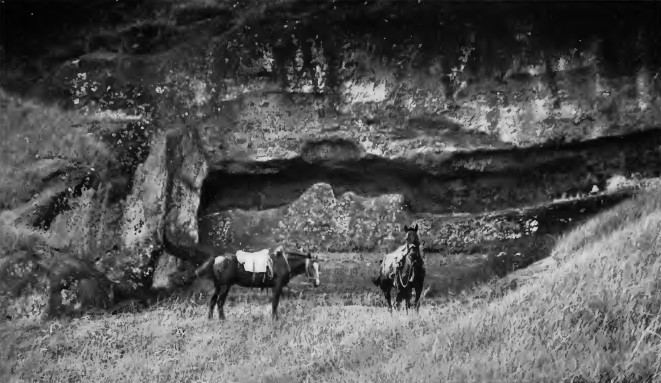 FIG. 49. — STATUE
IN QUARRY, PARTIALLY
SCULPTURED.
[No. 41, Fig. 60]
FIG. 49. — STATUE
IN QUARRY, PARTIALLY
SCULPTURED.
[No. 41, Fig. 60]
In other
instances the images have been carved lying, not horizontally, but
vertically,
with sometimes the head, and sometimes the base, toward the summit of
the hill.
But no exact system has been followed, the figures are found in all
places, and
all positions. When there was a suitable piece of rock it has been
carved into
a statue, without any special regard to surroundings or direction.
Interspersed
with embryo and completed images are empty niches from which others
have
already been removed; and finished statues must, in some cases, have
been
passed out over the top of those still in course of construction. From
all the
outside quarries is seen the same wonderful panorama: immediately
beneath are
the statues which stand on the lower slopes; farther still lie the
prostrate
ones beside the approach; while beyond is the whole stretch of the
southern
plain, with its white line of breaking surf ending in the western
mountain of
Rano Kao (fig. 54).
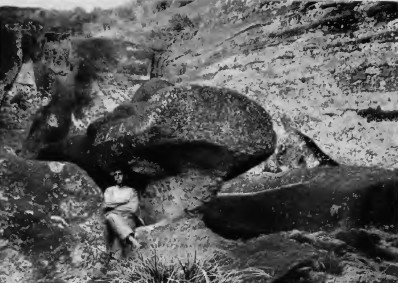 FIG. 50. — STATUE
IN QUARRY.
Attached to rock by
"keel" only.
Top of head (flat surface) towards spectator. [No. 61. Fig. 60.]
FIG. 50. — STATUE
IN QUARRY.
Attached to rock by
"keel" only.
Top of head (flat surface) towards spectator. [No. 61. Fig. 60.]
The
quarries within the crater are on the same lines as those without, save
that
those on the south-eastern side form a more continuous whole. Here the
most
striking position is on the top of the seaward cliff, in the centre of
which is
a large finished image (no. 16, fig. 47); on one side the ground falls
away
more or less steeply to the crater-lake, on the other a stone thrown
down would
reach the foot of the precipice; the view extends from sea to sea. Over
all the
most absolute stillness reigns.
The
statues in the quarries number altogether over 150. Amongst this mass
of
material there is no difficulty in tracing the course of the work. The
surface
of the rock, which will form the figure, has generally been laid bare
before
work upon it began, but occasionally the image was wrought lying
partially
under a canopy (fig. 49). In a few cases the stone has been roughed out
into
preliminary blocks (no. 58, fig. 60), but this procedure is not
universal, and
seems to have been followed only where there was some doubt as to the
quality
of the material. When this was not the case the face and anterior
aspect of the
statue were first carved, and the block gradually became isolated as
the
material was removed in forming the head, base, and sides. A gutter or
alley-way was thus made round the image (fig. 55) , in which the niches
where
each man has stood or squatted to his work can be clearly seen; it is,
therefore, possible to count how many were at work at each side of a
figure.
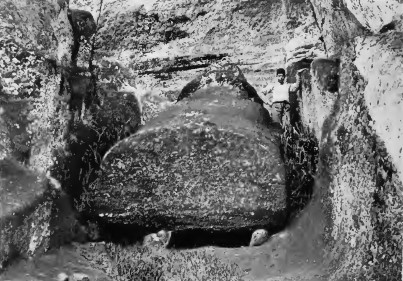 FIG. 51. — STATUE
IN QUARRY.
FIG. 51. — STATUE
IN QUARRY.
Ready to be
launched; movement prevented by stone wedges. Base towards spectator.
[No. 57.
Fig. 60.]
When the
front and sides were completed down to every detail of the hands, the
undercutting commenced. The rock beneath was chipped away by degrees
till the
statue rested only on a narrow strip of stone running along the spine;
those
which have been left at this stage resemble precisely a boat on its
keel, the
back being curved in the same way as a ship's bottom (fig. 50). In the
next
stage shown the figure is completely detached from the rock, and
chocked up by
stones, looking as if an inadvertent touch would send it sliding down
the hill
into the plain below (fig. 51). In one instance the moving has
evidently begun,
the image having been shifted out of the straight. In another very
interesting
case the work has been abandoned when the statue was in the middle of
its
descent; it has been carved in a horizontal position in the highest
part of the
quarry, where its empty niche is visible, it has then been slewed round
and was
being launched, base forward, across some other empty niches at a lower
level.
The bottom now rests on the floor of the quarry, and the figure, which
has
broken in half, is supported in a standing fashion against the outer
edge of
the vacated shelves. The first impression was that it had met with an
accident
in transit, and been abandoned; but it is at least equally possible
that for
the purpose of bringing it down, a bank or causeway of earth had been
built up
to level the inequalities of the descent, and that it was resting on
this when
the work came to an end; the soil would then in time be washed away,
and the
figure fracture through loss of support.
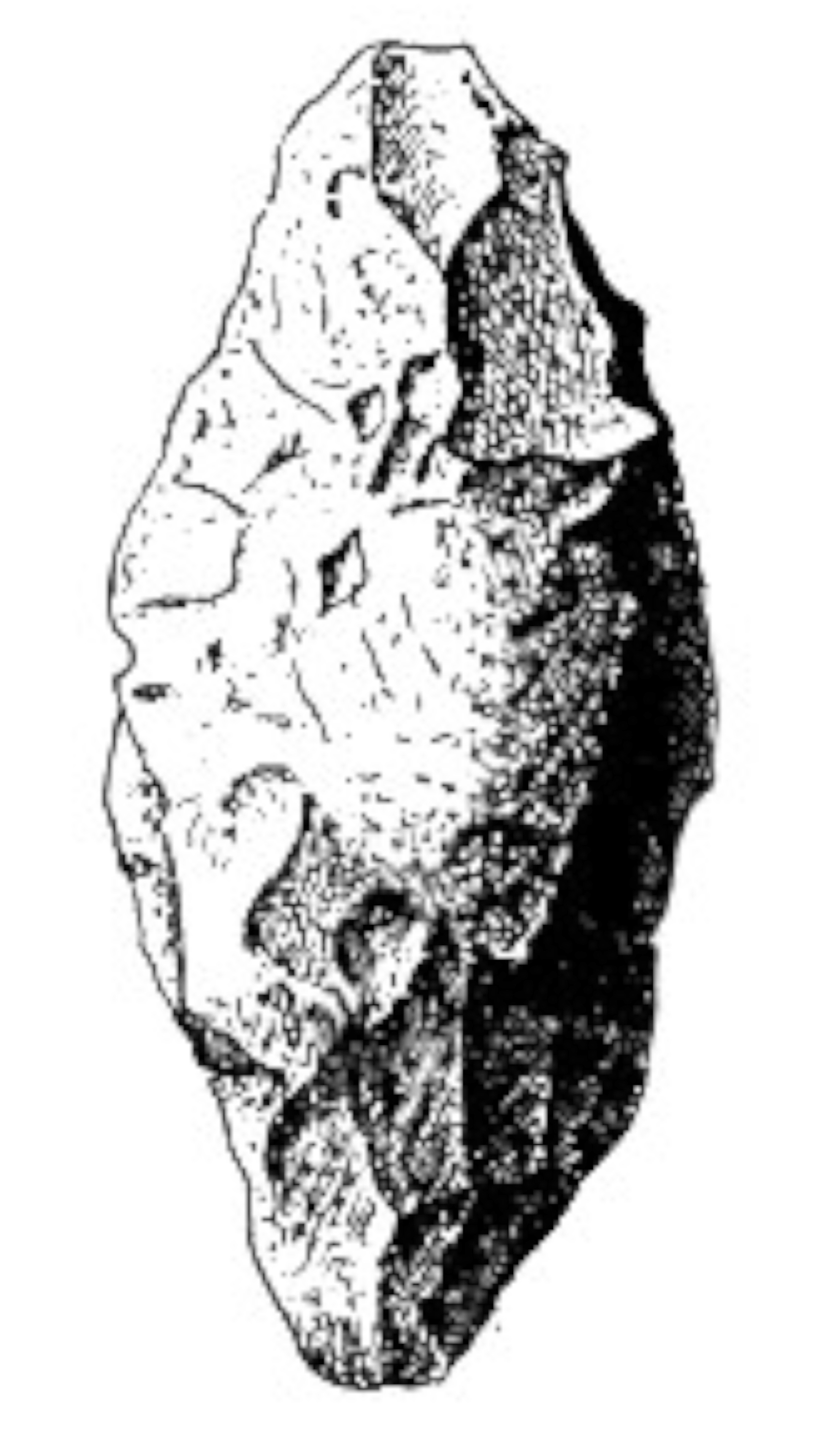
FIG. 52. —
STONE TOOLS (Toki).
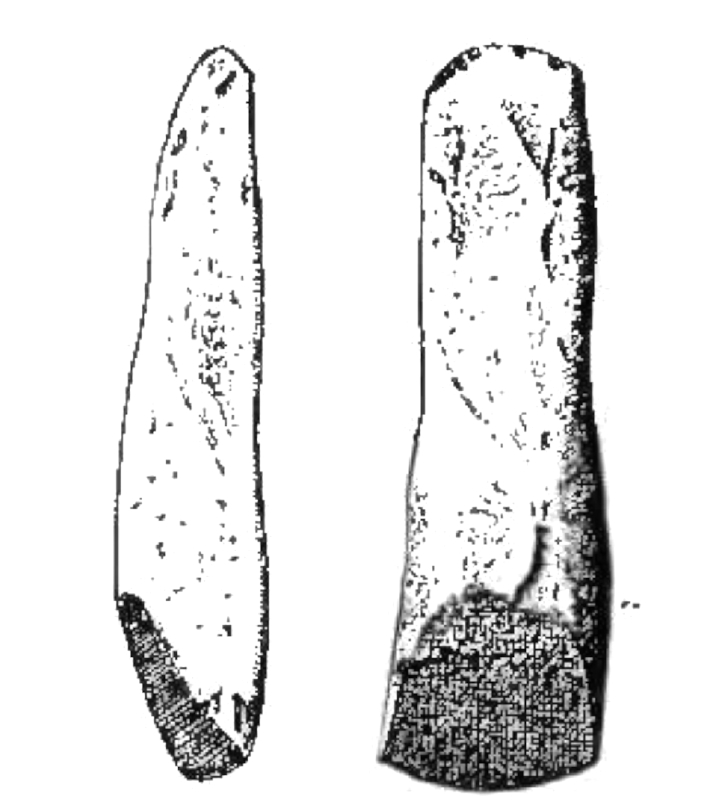 FIG. 53. — H.
Balfour del.
FIG. 53. — H.
Balfour del.
In the
quarry which is shown in fig. 54, the finished head can be seen lying
across
the opening, the body is missing, presumably broken off and buried; the
bottom
of the keel on which the figure at one time rested can be clearly
traced in a
projecting line of rock down the middle of its old bed, also the
different
sections where the various men employed have chipped away the stone in
undermining the statue. In the quarry wall the niches occupied by the
sculptors
are also visible, at more than one level, the higher ones being
discarded when
the upper portion of the work was finished and a lower station needed.
The hand
of the standing boy in fig. 51 rests on a small platform similarly
abandoned.
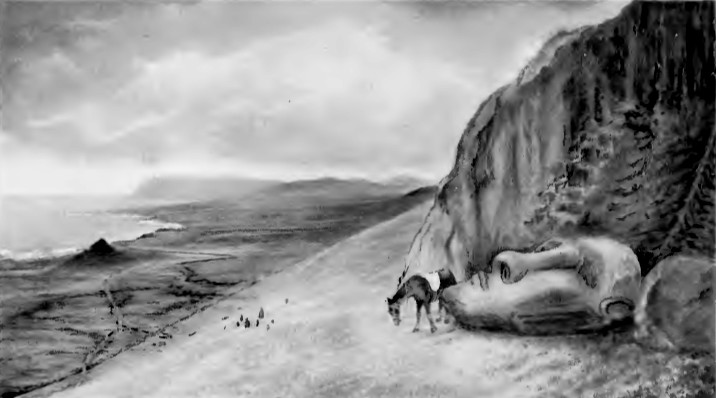 FIG. 54. — HEAD OF
A STATUE AT MOUTH OF
QUARRY FROM WHICH IT HAS BEEN HEWN.
[No. 72. Fig. 60.]
FIG. 54. — HEAD OF
A STATUE AT MOUTH OF
QUARRY FROM WHICH IT HAS BEEN HEWN.
[No. 72. Fig. 60.]
The tools
were found with which the work has been done. One type of these can be
seen
lying about in great abundance (fig. 52). They are of the same material
as the
lapilli in the statues, and made by flaking. Some specimens are pointed
at both
ends, others have one end more or less rounded. It is unlikely that
they were
hafted, and they were probably held in the hand when in use. They were
apparently discarded as soon as the point became damaged. There is
another tool
much more carefully made, an adze blade, with the lower end bevelled
off to
form the cutting edge. In the specimen shown, the top is much abraded
apparently from hammering with a maul or mallet (fig. 53). These are
rarely
found, the probability being that they were too precious to leave and
were
taken home by the workmen. The whole process was not necessarily very
lengthy;
a calculation of the number of men who could work at the stone at the
same
time, and the amount each could accomplish, gave the rather surprising
result
that a statue might be roughed out within the space of fifteen days.
The most
notable part of the work was the skill which kept the figure so perfect
in
design and balance that it was subsequently able to maintain its
equilibrium in
a standing position; to this it is difficult to pay too high a tribute.
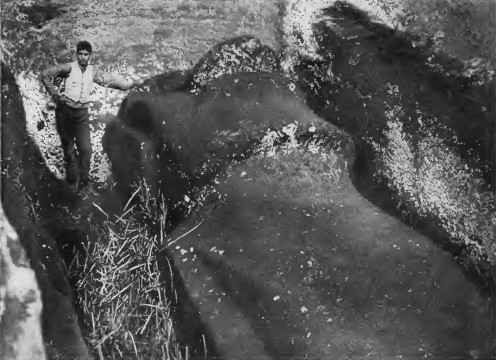 FIG. 55. — UPPER
PORTION OF LARGEST IMAGE IN
QUARRY, WITH ALLEY-WAY FOR WORKMEN.
[No. 64. Fig. 50.]
FIG. 55. — UPPER
PORTION OF LARGEST IMAGE IN
QUARRY, WITH ALLEY-WAY FOR WORKMEN.
[No. 64. Fig. 50.]
It
remains to account for the vast number of images to be found in the
quarry. A
certain number have, no doubt, been abandoned prior to the general
cessation of
the work; in some cases a flaw has been found in the rock and the
original plan
has had to be given up — in this case, part of the stone is sometimes
used for
either a smaller image or one cut at a different angle. In other
instances the
sculptors have been unlucky enough to come across at important points
one or
more of the hard nodules with which their tools could not deal, and as
the work
could not go down to posterity with a large wart on its nose or
excrescence on
its chin, it has had to be stopped. But when all these instances have
been
subtracted, the amount of figures remaining in the quarries is still
startlingly large when compared with the number which have been taken
out of
it, and must have necessitated, if they were all in hand at once, a
number of
workers out of all proportion to any population which the island has
ever been
likely to have maintained. The theory naturally suggests itself that
some were
merely rock-carvings and not intended to be removed. It is one which
needs to
be adopted with caution, for more than once, where every appearance has
pointed
to its being correct, a similar neighbour has been found which was
actually
being removed; on the whole, however, there can be little doubt that it
is at
any rate a partial solution of the problem. Some of the images are
little more
than embossed carvings on the face of the rock without surrounding
alley-ways.
In one instance, inside the crater, a piece of rock which has been left
standing on the very summit of the cliff has been utilised in such a
way that
the figure lies on its side, while its back is formed by the outward
precipice
(fig. 56); this is contrary to all usual methods, and it seems
improbable that
it was intended to make it into a standing statue. Perhaps the
strongest
evidence is afforded by the size of some of the statues: the largest
(fig. 55;
no. 64, fig. 60) is 66 feet in length, whereas 36 feet is the extreme
ever
found outside the quarry; tradition, it is true, points out the ahu on
the
south coast for which this monster was designed, but it is difficult to
believe
it was ever intended to move such a mass. If this theory is correct, it
would
be interesting to know whether the stage of carving came first, and
that of
removal followed, as the workmen became more expert; or whether it was
the
result of decadence when labour may have become scarce. It is, of
course,
possible that the two methods proceeded concurrently, rock-carvings
being
within the means of those who could not procure the labour necessary to
move
the statue.
Legendary
lore throws no light on these matters, nor on the reasons which led to
the
desertion of this labyrinth of work; it has invented a story which
entirely
satisfies the native mind and is repeated on every occasion. There was
a
certain old woman who lived at the southern corner of the mountain and
tilled
the position of cook to the image-makers. She was the most important
person of
the establishment, and moved the images by supernatural power (Mana), ordering them about at her will.
One day, when she was away, the workers obtained a fine lobster, which
had been
caught on the west coast, and ate it up, leaving none for her;
unfortunately
they forgot to conceal the remains, and when the cook returned and
found how
she had been treated, she arose in her wrath, told all the images to
fall down,
and thus brought the work to a standstill.
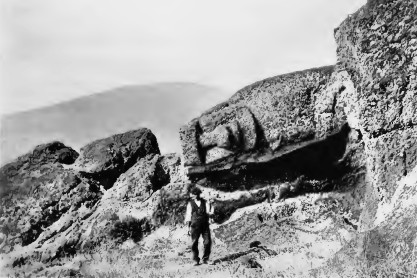 FIG. 56. — STATUE
CARVED ON EDGE OF
PRECIPICE. INTERIOR OF CRATER.
[No. 27. Fig. 47.]
FIG. 56. — STATUE
CARVED ON EDGE OF
PRECIPICE. INTERIOR OF CRATER.
[No. 27. Fig. 47.]
Standing Statues of Rano
Raraku. —
Descending from the quarries, we turn to the figures below. A few at
the foot
of the mountain have obviously been thrown down; one of these (no . 6,
fig. 60)
was wrecked in the same conflict as the one on Ahu Paro, and one is
shown where
an attempt has been made to cut off the head. Another series of images
have
originally stood round the base on level ground (nos. 1, 2, 3, fig.
60),
extending from the exterior of the entrance to the crater to the
southern
corner; these are all prostrate. On the slopes there are a few
horizontal
statues, but the great majority, both inside the crater and without,
are still
erect. Outside, some forty figures stand in an irregular belt, reaching
from
the corner nearest the sea to about half-way to the gap leading into
the
crater. The bottom of the mountain is here diversified by little
hillocks and
depressions; these hillocks would have made commanding situations, but
rather
curiously the statues, while erected quite close to them, and even on
their sides,
are never on the top. Inside the crater, where some twenty statues are
still
erect, the arrangement is rather more regular; but, on the whole, they
are put
up in no apparent order. All stood with their backs to the mountain.
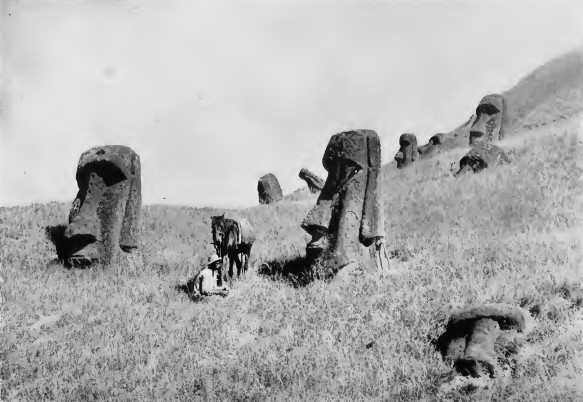 No. 32.
No. 33.
No.
34.
FIG. 57. — STANDING
STATUES ON EXTERIOR OF
RANO RARAKU SHOWING PARTIAL BURIAL
No. 32.
No. 33.
No.
34.
FIG. 57. — STANDING
STATUES ON EXTERIOR OF
RANO RARAKU SHOWING PARTIAL BURIAL
They vary
very considerably in size; the tallest which could be measured from its
base
was 32 feet 3 inches, while others are not much above 11 feet. Every
statue is
buried in greater or less degree, but while some are exposed as far as
the
elbow, in others only a portion of the top of the head can be seen
above the
surface (fig. 57), others no doubt are covered entirely. The number
visible
must vary from time to time, as by the movement of the earth some are
buried
and others disclosed. An old man, whose testimony was generally
reliable,
stated, when speaking of the figures on the outside of the mountain,
that while
those nearer the sea were in the same condition as he always remembered
them,
those farther from it were now more deeply buried than in his youth.
Various
old people were brought out from the village at Hanga Roa to pay visits
to the
camp, but the information forthcoming was never of great extent; one
elderly
gentleman in particular took much more interest in roaming round the
mountain,
recalling various scenes of his youth, than in anything connected with
the
statues. A few names are still remembered in connection with the
individual
figures, and are said to be those of the makers of the images, and some
proof
is afforded of the reality of the tradition by the fact that the clans
of the
persons named are consistently given. Another class of names is,
however,
obviously derived merely from local circumstances; one in the quarry,
under a
drip from above, is known by the equivalent for "Dropping Water,"
while a series inside the crater are called after the birds which
frequent the
cliff-side, “Kia-kia, Flying," "Kia-kia, Sitting," and so forth.
A solitary legend relates to an unique figure, resembling rather a
block than
an image, which lies on the surface on the outside of the mountain (no.
24,
fig. 60). It is the single exception to the rule mentioned above, that
no
evolution can be traced in the statues on the island. The usual
conception is
there, and the hands are shown, but the head seems to melt into the
body and
the ear and arm to have become confused. It is said to have been the
first
image made and is known as Tai-hare-atua, which tradition says was the
name of
the maker. He found himself unable to fashion it properly, and went
over to the
other side of the island to consult with a man who lived near Hanga
Roa, named
Rauwai-ika. He stayed the night there, but the expert remained silent,
and he
was retiring disappointed in the morning, when he was followed by his
host, who
called him back. “Make your image," said he, “like me," — that is, in
form of a man.
On our
first visit to the mountain, overcome by the wonder of the scene, we
turned to
our Fernandez boy and asked him what he thought of the statues. Like
the
classical curate, when the bishop inquired as to the character of his
egg, he
struggled manfully between the desire to please and a sense of truth;
like the
curate, he took refuge in compromise. “Some of them," he said
doubtfully,
he thought "were very nice." If the figures at first strike even the
cultured observer as crude and archaic, it must be remembered that not
only are
they the work of stone tools, but to be rightly seen should not be
scrutinised
near at hand. “Hoa-haka-nanaia," for instance, is wholly and dismally
out
of place under a smoky portico, but on the slopes of a mountain, gazing
in
impenetrable calm over sea and land, the simplicity of outline is soon
found to
be marvellously impressive. The longer the acquaintance the more this
feeling
strengthens; there is always the sense of quiet dignity, of suggestion
and of
mystery.
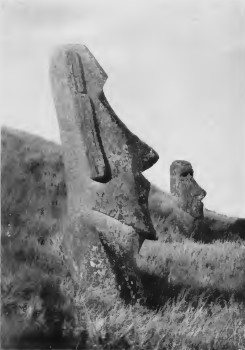 FIG. 58 — STATUES
ON RANO RARAKU, SHOWING
DISTENSION OF EAR.
LOBE REPRESENTED AS
A ROPE.
[Nos. 27 and 29.
Fig. 60.]
FIG. 58 — STATUES
ON RANO RARAKU, SHOWING
DISTENSION OF EAR.
LOBE REPRESENTED AS
A ROPE.
[Nos. 27 and 29.
Fig. 60.]
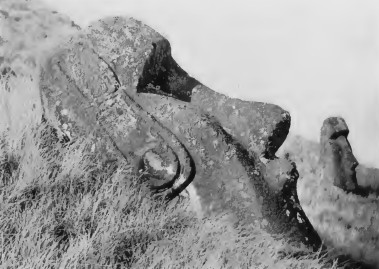 FIG. 59. —LOBE
CONTAINING A DISC [No. 23.
Fig. 60.]
FIG. 59. —LOBE
CONTAINING A DISC [No. 23.
Fig. 60.]
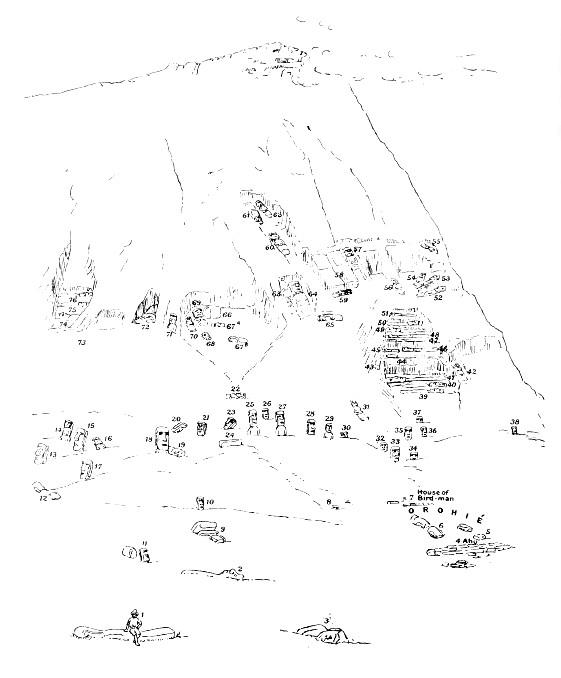 FIG. 60A. — KEY TO
DIAGRAMMATIC SKETCH
FIG. 60A. — KEY TO
DIAGRAMMATIC SKETCH
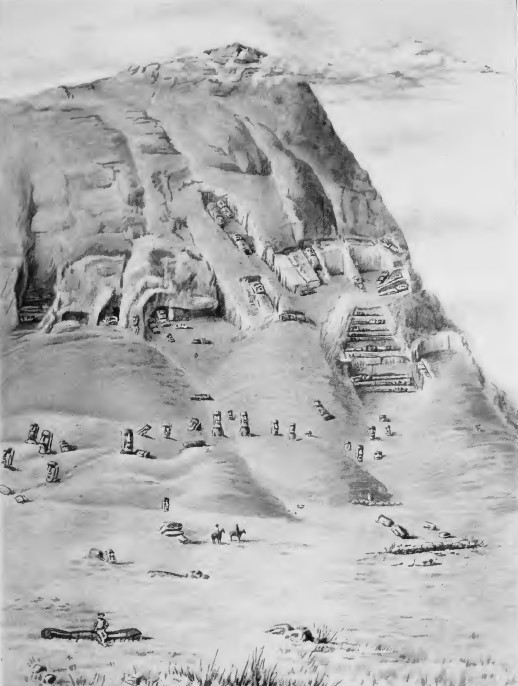 FIG. 60. — EXTERIOR
OF RANO RARAKU. EASTERN
PORTION OF SOUTHERN ASPECT.
Diagrammatic sketch
showing position of
statues.
FIG. 60. — EXTERIOR
OF RANO RARAKU. EASTERN
PORTION OF SOUTHERN ASPECT.
Diagrammatic sketch
showing position of
statues.
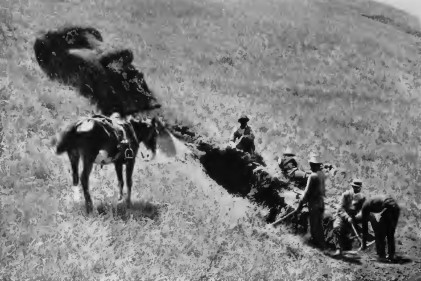 FIG. 61. — DIGGING
OUT A STATUE.
For same image
after excavation see fig. 69.
FIG. 61. — DIGGING
OUT A STATUE.
For same image
after excavation see fig. 69.
While the
scene on Raraku always arouses a species of awe, it is particularly
inspiring
at sunset, when, as the light fades, the images gradually become
outlined as
stupendous black figures against the gorgeous colouring of the west.
The most striking
sight witnessed on the island was a fire on the hill-side; in order to
see our
work more clearly we set alight the long dry grass, always a virtuous
act on
Easter Island that the live-stock may have the benefit of fresh shoots;
in a
moment the whole was a blaze, the mountain, wreathed in masses of
driving
smoke, grew to portentous size, the quarries loomed down from above as
dark
giant masses, and in the whirl of flame below the great statues stood
out
calmly, with a quiet smile, like stoical souls in Hades.
The
questions which arise are obvious: do these buried statues differ in
any way
from those in the workings above, from those on the ahu or from one
another?
were they put up on any foundation? and, above all, what is the history
of the
mountain and the raison d’être of the
figures? In the hope of throwing some light on these problems we
started to dig
them out. It had originally been thought that the excavation of one or
two
would give all the information which it was possible to obtain, but
each case
was found to have unique and instructive features, and we finally
unearthed in
this way, wholly or in part, some twenty or thirty statues. It was
usually easy
to trace the stages by which the figures had been gradually covered. On
the top
was a layer of surface soil, from 3 to 8 inches in depth; then came
debris,
which had descended from the quarry above in the form of rubble, it
contained large
numbers of chisels, some forty of which have been found in digging out
one
statue; below this was the substance in which a hole had been dug to
erect the
image, it sometimes consisted of clay and occasionally in part of rock.
Not
unfrequently the successive descents of earth could be traced by the
thin lines
of charcoal which marked the old surfaces, obviously the result of
grass or
brushwood fires. The few statues which are in a horizontal position are
always
on the surface (no. 31, fig. 60), and at first give the impression that
they
have been abandoned in the course of being brought down from the
quarries; as
they are frequently found close to standing images, of which only the
head is
visible, it follows that, if this is the correct solution, the work
must still
have been proceeding when the earlier statues were already largely
submerged.
The juxtaposition, however, occurs so often that it seems, on the
whole, more
probable that the rush of earth which covered some, upset the
foundations of
others, and either threw them down where they stood or carried them
with it on
top of the flood. These various landslips allow of no approximate
deductions as
to the date, in the manner which is possible with successively
deposited layers
of earth.
To get
absolutely below the base of an image was not altogether easy. The
first we
attempted to dig out was one of the farther ones within the crater (no.
19,
fig. 47); it was found that, while the back of the hole into which it
had been
dropped was excavated in the soft volcanic ash, the front and remaining
sides
were of hard rock. This rock was cut to the curvature of the figure at
a
distance of some 3 inches from it, and as the chisel marks were
horizontal,
from right to left, the workmen must have stood in the cup while
preparing it:
in clearing out the alluvium between the wall of the cup and the
figure, six
stone implements were found. The hands, which were about 1 foot below
the level
of the rim, were perfectly formed. The next statue chosen for
excavation was
also inside the crater (no. 107, fig. 47); it was most easily attacked
from the
side, and this time it was possible to get low enough to see that it
stood on
no foundation, and that the base instead of expanding, as with those
which
stood on the ahu, contracted in such a manner as to give a peg-shaped
appearance; this confirmed the impression made by the previous
excavation, that
the image was intended to remain in its hole and was not, as some have
stated,
merely awaiting removal to an ahu (fig. 62).
EXCAVATED
IMAGES.
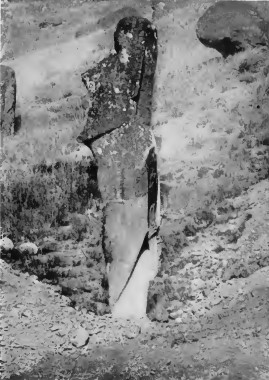 FIG. 62. — Showing
effect of weathering and
peg-shaped base.
[No. 107. Fig. 47.]
FIG. 62. — Showing
effect of weathering and
peg-shaped base.
[No. 107. Fig. 47.]
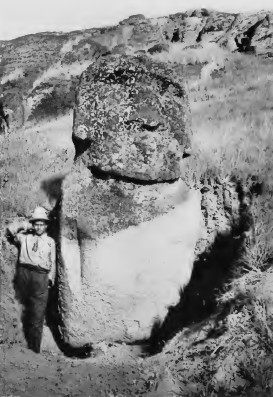 FIG. 63. — Showing
scamped work in lower part
of figure, no right hand carved, and surface only coarsely chiselled.
[No. 36. Fig. 47.]
DESIGNS
ON BACKS OF IMAGES.
FIG. 63. — Showing
scamped work in lower part
of figure, no right hand carved, and surface only coarsely chiselled.
[No. 36. Fig. 47.]
DESIGNS
ON BACKS OF IMAGES.
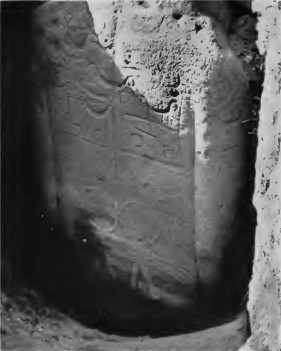 FIG. 64. —
BACK OF AN EXCAVATED STATUE.
Showing
{a) typical raised rings and girdle; (6) exceptional incised carvings.
[No. 109.
Fig. 47.]
FIG. 64. —
BACK OF AN EXCAVATED STATUE.
Showing
{a) typical raised rings and girdle; (6) exceptional incised carvings.
[No. 109.
Fig. 47.]
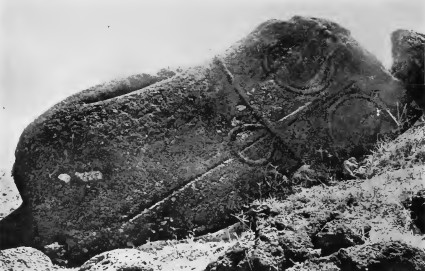 P.
Edmunds.
FIG. 65. — STATUE
ON AN AHU AT ANAKENA. Rings
on centre and lower portion of back.
P.
Edmunds.
FIG. 65. — STATUE
ON AN AHU AT ANAKENA. Rings
on centre and lower portion of back.
The story
was shown not only in the sections of the excavation, but in the
degrees of
weathering on the figure itself: the lowest part of the image to above
the
elbow exhibited, by the sharpness of its outlines and frequently of the
chisel
cuts also, that it had never been exposed, the other portions being
worn in
relative degrees. Traces of the smoothness of the original surface can
still be
seen above-ground in the more protected portions of some of the
statues, such
as in the orbit and under the chin (see frontispiece); but a much
clearer
impression is of course gained of the finish and detail of the image
when the
unweathered surface is exposed. The polish is often very beautiful, and
pieces
of pumice, called "punga," are found, with which the figures are said
to have been rubbed down. The fingers taper, and the excessive length
of the
thumb-joint and nail are remarkable (fig. 72). The nipples are in some
cases so
pronounced that the natives often characterised them as feminine, but
in no
case which we came across did the statues represent other than the nude
male
figure1; the navel is indicated by a raised disc. On the
statue with
the contracting base, which is one of the best, the surface modelling
of the
elbowjoint is clearly shown. The orbital cavity in the figures on
Raraku is
rather differently modelled from those on the ahu; in the statues on
the
mountain the position of the eyeball is always indicated by a straight
line
below the brow, the orbit has no lower border (fig. 72). On the
terraces the
socket is constantly hollowed out as in the figure at the British
Museum (fig.
31).
The eye
is the only point in which the two sets vary, with the important
exception that
some on the mountain have a type of back which never appears on the
ahu. This
question of back proved to be of special interest: in some images it
remained
exactly as when the figure left the quarry, the whole was convex,
giving it a
thick and archaic appearance, particularly as regards the neck; in
other
instances, the posterior was beautifully modelled after the same
fashion as
those on the terraces, the stone had been carefully chipped away till
the ears
stood out from the back of the head, the neck assumed definite form,
and the
spine, instead of standing out as a sharp ridge, was represented by an
incised
line. This second type, when excavated, proved, to our surprise, to
possess a
well-carved design in the form of a girdle shown by three raised bands,
this
was surmounted by one or sometimes by two rings, and immediately
beneath it was
another design somewhat in the shape of an M (figs. 64 and 106). The
whole was
new, not only to us, but to the natives, who greatly admired it. Later,
when we
knew what to look for, traces of the girdle could be seen also on the
figures
on the ahu where the arm had protected it from the weather. It was
afterwards
realised with amusement that the discovery of this design might have
been made
before leaving England by merely passing the barrier and walking behind
the
statues in the Bloomsbury portico. One case was found, a statue at
Anakena,
where a ring was visible, not only on the back but also on each of the
buttocks, and in view of subsequent information these lower rings
became of
special importance. The girdle in this case consisted of one line only;
the
detail of the carving had doubtless been preserved by being, buried in
the sand
(fig. 65) . The two forms of back, unmodelled and modelled, stand side
by side
on the mountain (figs. 66, 67).
The next
step was to discover where and when the modelling was done. Certainly
not in
the original place in the quarry, where it would be impossible from the
position in which the image was evolved; generally speaking there was
no trace
of such work, and it was not until many months later that new light was
thrown
on the matter. Then it was remarked that in one of the standing statues
on the
outside of the hill, which was buried up to the neck (fig. 59), while
the right
ear was most •carefully modelled, showing a disc, the left ear was as
yet quite
plain, and that the back of the head also was not symmetrical.
Excavations made
clear that the whole back was in course of transformation from the
boat-shaped
to the modelled type, each workman apparently chipping away where it
seemed to
him good (fig. 68). Two or three similar cases were then found on which
work
was proceeding; but on the other hand, some of the simpler backs were
excavated
to the foot, and others a considerable distance, and there was no
indication
that any alteration was intended. There are three possible explanations
for these-erect
and partially moulded statues: Firstly, it may have been the regular
method for
the back to be completed after the statue was set up, in which case
some kind
of staging must have been used; one of our guides had made a remark,
noted, but
not taken very seriously at the moment, that "the statues were set up
to
be finished"; some knowledge or tradition of such work, therefore,
appeared to linger. Secondly, the convex back may be the older form,
and those
on which work was being done were being modelled to bring them up to
date.
Alteration did at times take place; a certain small image presented a
very
curious appearance both from the proportion of the body, which was
singularly
narrow from back to front, and because it was difficult to see how it
remained
in place as it was apparently exposed to the base; it turned out that
the
figure had been carved out of the head of an older statue, of which the
body
was buried below (no. 14, fig. 60). Thirdly, these particular figures
may have
been erected and left in an unfinished condition; if so, their
deficiencies
were high up and would be obvious
BACKS OF STANDING
STATUES, RANO RARAKU
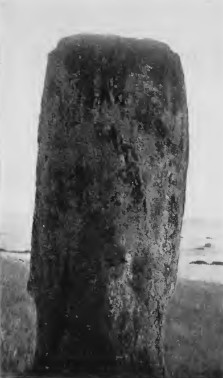 FIG. 66. —Unmodelled
FIG. 66. —Unmodelled
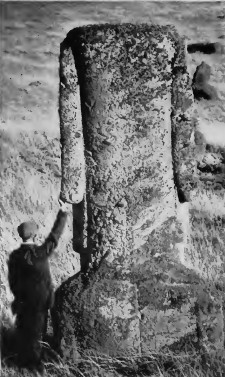 FIG. 67. —Modelled
EXCAVATED
STATUES
FIG. 67. —Modelled
EXCAVATED
STATUES
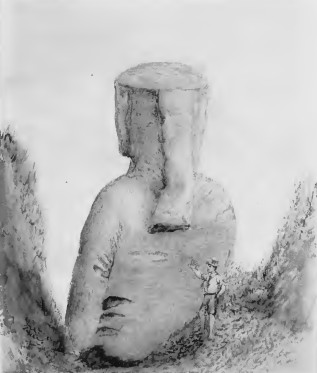 FIG. 68. — Showing
back in process of being
modelled.
[No.
23. Fig. 50]
FIG. 68. — Showing
back in process of being
modelled.
[No.
23. Fig. 50]
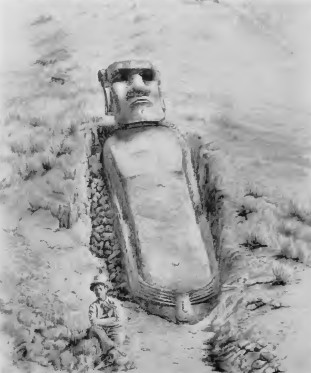 FIG. 69. — Showing
image wedged by boulders
FIG. 69. — Showing
image wedged by boulders
Scamping
did not often occur, and when it did so it was in the concealed
portions. In
one case the left hand was correctly modelled, but the right was not
even
indicated beyond the wrist (fig. 63). The statue shown in the
frontispiece,
which rejoices in the name of Piro-piro, meaning "bad odour,"2
stands at the foot of the slope, and appears to remain as it was set up
without
further burial. It is a well-made figure, probably one of the most
recent, and
the upper part of the back is carefully moulded, but on digging it out
it was
found that the bottom had not been finished, but left in the form of a
rough
excrescence of stone; there was no ring, but a girdle had been carved
on the
protruding portion, so that this was not intended to be removed. In
another
instance a large head had fallen on a slope at such an angle that it
was
impossible to locate the position of the body; curiosity led to
investigation,
when it was found that the thing was a fraud, the magnificent head
being
attached to a little dwarf trunk, which must have been buried
originally nearly
to the neck to keep the top upright. These instances of "jerrybuilding"
confirm our impression that at any rate a large number of the statues
were
intended to remain in situ.
Indications
were found of two different methods of erection, and the mode may have
been
determined by the nature of the ground. By the first procedure the
statue seems
to have been placed on its face in the desired spot, and a hole to have
been
dug beneath the base. The other method was to undermine the base, with
the
statue lying face uppermost; in several instances a number of large
stones were
found behind the back of the figure, evidently having been used to
wedge it while
it was dragged to the vertical. The upright position had sometimes been
only
partially attained; one statue was still in a slanting attitude,
corresponding
exactly to the slope of a hard clay wall behind it; the interval
between the
two, varying from three yards to eighteen inches, had been packed with
sub-angular boulders which weighed about one hundredweight, or as much
as a man
could lift (fig. 69) .
A few of
the figures bear incised markings rudely, and apparently promiscuously,
carved.
This was first noted in the case of one of two statues which stand
together
nearest to the entrance of the crater; here it has been found possible
to work
the rock at a low level, and in the empty quarry, from which they no
doubt have
been taken, two images have been set up, one slightly in front of the
other;
six still unfinished figures lie in close proximity (figs. 70 and 71).
The
standing figure, nearest to the lake, bore a rough design on the face,
and when
it was dug out the back was found to be covered with similar incised
marks. The
natives were much excited, and convinced that we should receive a large
sum of
money in England when the photograph of these was produced, for nothing
ever
dispelled the illusion that the expedition was a financial speculation.
It was
these carvings more especially that we ourselves hastily endeavoured to
cover
up when, on the arrival of Admiral von Spec's Squadron, we daily
expected a
visit from the officers on board. The markings have certainly not been
made by
the same practised hand as the raised girdle and rings, and appear to
be
comparatively recent (fig. 64). Other statues were excavated, where
similar
marks were noticed, but, except in this case, digging led practically
always to
disappointment. It was the part above the surface only which had been
used as a
block on which to scrawl design, from the same impulse presumably as
impels the
school-boy of to-day to make marks with chalk on a hoarding. On one ahu
the top
of the head of a statue has been decorated with rough faces, the
carving
evidently having been done after the statue had fallen.
In
digging out the image with the tattooed back, we came across the one
and only
burial which was found in connection with these figures; it was close
to it and
at the level of the rings. The long bones, the patella, and base of the
skull
were identified; they lay in wet soil, crushed and intermixed with
large
stones, so the attitude could not be determined beyond the fact that
the head
was to the right of the image and the long bones to the left. These
bones had
become of the consistency of moist clay, and could only be identified
by making
transverse sections of them with a knife, after first cleaning portions
longitudinally by careful scraping.
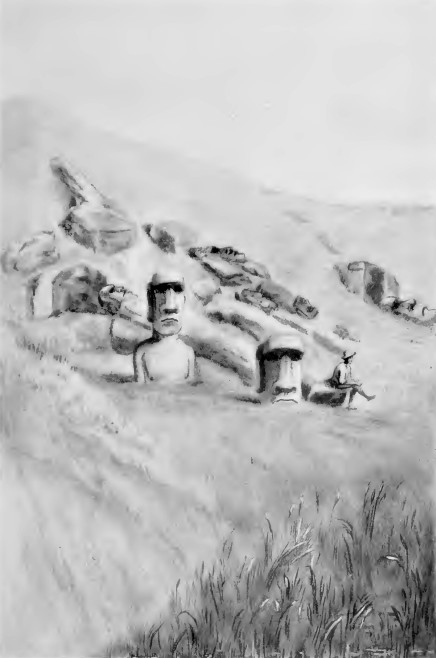 FIG. 70. — TWO
IMAGES ERECTED IN QUARRY.
FRONT VIEW.
Prior to excavation.
[Nos.
108-109. Fig
47]
FIG. 70. — TWO
IMAGES ERECTED IN QUARRY.
FRONT VIEW.
Prior to excavation.
[Nos.
108-109. Fig
47]
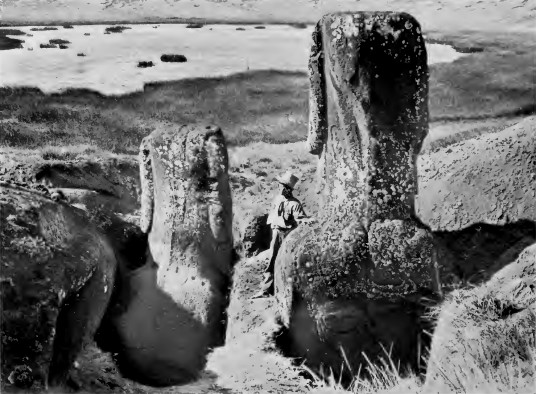 FIG. 71. — TWO
IMAGES ERECTED IN QUARRY.
BACK VIEW.
After excavation.
[Nos. 109-108. Fig
47. See also Fig. 64.]
FIG. 71. — TWO
IMAGES ERECTED IN QUARRY.
BACK VIEW.
After excavation.
[Nos. 109-108. Fig
47. See also Fig. 64.]
In
several other instances human bones were discovered near the statues,
but, like
the carvings, they appeared to be of later date than the images. One
skull was
found beneath a figure which was lying face downwards on the surface;
another
fragment must have been placed behind the base after the statue had
fallen
forward. The natives stated that in the epidemics which
ravaged the island the statues afforded a
natural mark for depositing remains. In the same way a head near an
ahu, which
was at first thought to be that of a standing statue, turned out to be
broken
from the trunk and put up pathetically to mark the grave of a little
child.
There is a roughly constructed ahu on the outside of Rano Raraku at the
corner
nearest to the sea, of which more will be said hereafter, and a
quarried block
of rock on the very top of the westerly peak was also said to be used
for the
exposure of the dead (no. 75, fig. 47). Close to this block there are
some very
curious circular pits cut in the rock; one examined was 5 feet 6 inches
in
depth and 3 feet 6 inches in diameter (no. 74, fig. 47). It is possible
they
were used as vaults, but, if so, the shape is quite different from
those of the
ahu. The conclusion arrived at was that the statues themselves were not
directly connected with burials. There seems also no reason to believe
that
they are put up in any order or method; they appear to have been
erected on any
spot handy to the quarries where there was sufficient earth, or even,
as has
been seen, in the quarry itself when circumstances permitted.
The South-Eastern Side of
Rano Raraku is a
problem in itself. The great wall formed by the cliff is like the
ramparts of
some giant castle rent by vertical fissures. The greatest height, the
top of
the peak, is about five hundred feet, of which the cliff forms perhaps
half,
the lower part being a steep but comparatively smooth bank of detritus.
Over
the grassy surface of this bank are scattered numerous fragments of
rock,
weighing from a few pounds to many tons, which have fallen down from
above. The
kitchen tent in our camp at the foot had a narrow escape from being
demolished
by one of these stones, which nearly carried it away in the impetus of
its
descent. It has never been suggested that this face of the mountain was
being
worked, nevertheless, it was subsequently difficult to understand how
we lived
so long below it, gazing at it daily, before we appreciated the fact
that here
also, although in much lesser degree, were both finished and embryo
images. At
last one stone was definitely seen to be in the form of a head, and
excavation
showed it to be an erected and buried statue. A few other figures were
found
standing and prostrate, and some unfinished images; these last,
however, were
in no case being hewn out of solid rock, but wrought into shape out of
detached
stones. On the whole, it is not probable that this portion was ever a
quarry,
in the same way as the western side and the interior of the crater. It
is, of
course, impossible to say what may be hidden beneath the detritus, but
the
lower part of the cliff is too soft a rock to be satisfactorily hewn,
and the
workmen appear simply to have seized on fragments which have fallen
from above.
“Here," they seem to have said, “is a good stone; let us turn it into a
statue."
One day,
when making a more thorough examination of the slope, our attention was
excited
by a small level plateau, about half-way up, from which protruded two
similar
pieces of stone next to one another. They were obviously giant noses of
which
the nostrils faced the cliff. Digging was bound to follow, but it
proved a long
business, as the figures it revealed were particularly massive and
corpulent.
Their position was horizontal, side by side, and the effect, more
particularly
when looking down at them from the cliff above, was of two great bodies
lying
in their graves (fig. 73). The thing was a mystery; they were certainly
not in
a quarry, but if they had once been erect, why had they faced the
mountain,
instead of conforming to the rule of having their back to it?
Orientation could
not account for it, as other statues on the same slope were differently
placed.
Then again, if they had once stood and then fallen, and in proof of
this one
head was broken off from the trunk, how did it come about that they
were lying
horizontally on a sloping hill-side? The upper part of the bodies had
suffered somewhat
from weather, and a small round basin, such as natives use for domestic
purposes, had been hollowed out in one abdomen, but the hands were
quite sharp
and unweathered. We used to scramble up at off moments, and stand
gazing down
at them trying to read their history.
It became
at last obvious they had once been set up with the lower part inserted
in the
ground to the usual level, and later been intentionally thrown down.
For this
purpose a level trench must have been cut through the sloping side of
the hill
at a depth corresponding to the base of the standing images, and into
this the
figures had fallen. While they lay in the trench with the upper part of
the
bodies exposed, one had been found a nice smooth stone for household
use. A
charcoal soil level showed clearly where the surface had been at this
epoch,
which must have been comparatively recent, as an iron nail was found in
it.
Finally, a descent of earth had covered all but the noses, leaving them
in the
condition in which we found them.
This,
though a satisfactory explanation as far as it went, did not account
for the
fact that the figures were facing the mountain, and here for once
tradition
came to our help. These images had, it was said, marked a boundary; the
line of
demarcation led between them, from the fissure in the cliff above right
down to
the middle statue in the great Tongariki terrace. To cross it was
death; but as
to what the boundary connoted no information was forthcoming; there
seemed no
great tribal division — the same clans ranged over the whole of the
district.
When, however, the line is followed through the crevice into the crater
(fig.
47), it is found to form on both sides the boundary where the
image-making
ceased (no. i is a detached figure being brought down, not in a
quarry), and
was probably the line of taboo which preserved the rights of the
image-makers.
I was later given the cheering information that a certain "devil"
frequented the site of my house, which was just on the image side of
the
boundary, who particularly resented the presence of strangers, and was
given to
strangling them in the night. The spirits, who inhabit the crater, are
still so
unpleasant, that my Kanaka maid objected to taking clothes there to
wash, even
in daylight, till assured that our party would be working within call.
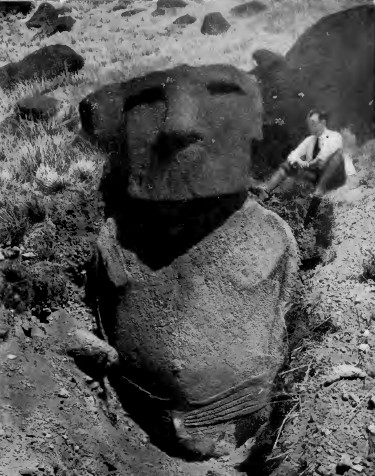 FIG. 72. — EXCAVATED
STATUE.
South-east side,
Rano Raraku. Showing form of
hands.
FIG. 72. — EXCAVATED
STATUE.
South-east side,
Rano Raraku. Showing form of
hands.
Isolated Statues. — The
finished statues, as distinct from those in the quarries, have so far
been
spoken of under two heads, those which once adorned the ahu and those
still
standing on the slope of Raraku; there is, however, another class to
consider,
which, for want of a better name, will be termed the Isolated Statues.
It has
already been stated that, as Raraku is approached, a number of figures
lie by
the side of the modern track, others are round the base of the
mountain, and
yet other isolated specimens are scattered about the island. All these
images
are prostrate and lie on the surface of the ground, some on their backs
and
some on their faces. These were the ones which, according to legend,
were being
moved from the quarries to the ahu by the old lady when she stopped the
work in
her wrath; or, according to another account, quoted by a visitor before
our day,
“They walked, and some fell by the way."
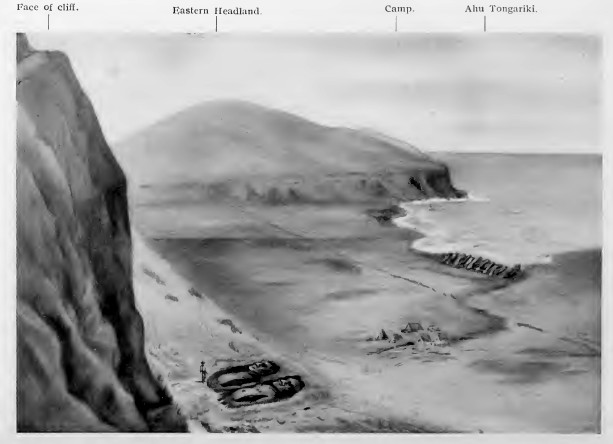 FIG. 73 — PROSTRATE
STATUES, SOUTH-EASE SIDE,
RANO RARAKU, AFTER EXCAVATION.
FIG. 73 — PROSTRATE
STATUES, SOUTH-EASE SIDE,
RANO RARAKU, AFTER EXCAVATION.
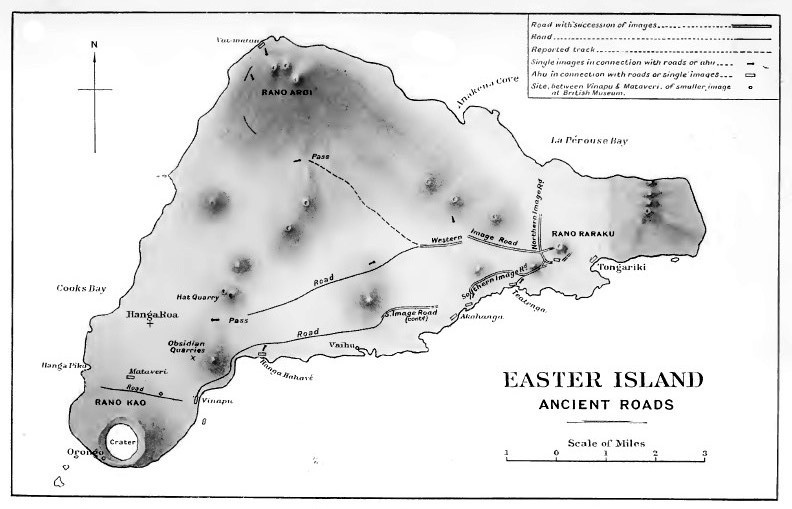 |
| FIG 74. |
There
must, we felt, have been roads along which they were taken, but for
long we
kept a look-out for such without success. At last a lazy Sunday
afternoon ride,
with no particular object, took one of us to the top of a small hill,
some two
miles to the west of Raraku. The level rays of the sinking sun showed
up the
inequalities of the ground, and, looking towards the sea, along the
level plain
of the south coast, the old track was clearly seen; it was slightly
raised over
lower ground and depressed somewhat through higher, and along it every
few
hundred yards lay
a
statue. Detailed study confirmed this first impression. At times over
hard stony ground the trail was lost, but its main drift was
indisputable; it was about nine feet or ten feet in width, the
embankments were
in places two feet above the surrounding ground, and the cuttings three
feet
deep. The road can be traced from the south-western corner of the
mountain,
with one or two gaps, nearly to the foot of Rano Kao, but the
succession of
statues continues only about half the distance. It generally runs some
few
hundred yards further inland than the present road, but a branch, with
a statue,
leads down to the ahu of Teatenga on the coast, and, another portion,
either a
branch or a detour of the main road, also with a statue, goes to the
cove of
Akahanga with its two large image ahu (fig. 32). There are on this road
twenty-seven statues in all, covering a distance of some four miles,
but
fourteen of them, including two groups of three, are in the first mile.
Their
heights are from fifteen feet to over thirty feet, but generally over
twenty
feet.
As a clue
had now been obtained, it was comparatively simple to trace two other
roads
from Raraku. One leads from the crater, and connects it with the
western
district of the island. It commences at the gap in the mountain wall,
in the
centre of which an image lies on its face with weird effect, as if
descending
head foremost into the plain; and runs for a while roughly parallel to
the
first road but about a mile further inland. It is not quite so regular
as the
south road, and is marked for a somewhat less distance by a sequence of
images,
some fourteen in number, which in the same way grow further apart as
the
distance from the mountain increases. When the succession of statues
ceases,
the road divides; one track turns to the north-west, and reaches the
sea-board
through a small pass in the western line of cones; the other continues
as far
as a more southerly pass in the same succession of heights. In each
pass there
is a statue.
The third
road, which runs from Raraku in a northerly direction, is much shorter
than
those to the south and west. It has only four statues covering a
distance of
perhaps a mile, and it then disappears; if, however, the figures round
the base
of the mountain belonged to it, and they lie in the same direction, it
started
from the southern corner of the mountain, led in front of the standing
statues
and across the trail from the crater, before taking its northward route
up the
eastern plain. The furthest of the images is the largest which has been
moved;
it lies on its back, badly broken, but the total of the fragments gives
a height
of thirty-six feet four inches. In addition to these three avenues,
there are
indications that some of the statues on the south-eastern side of
Raraku may
have been on a fourth road along that side beneath the cliff.
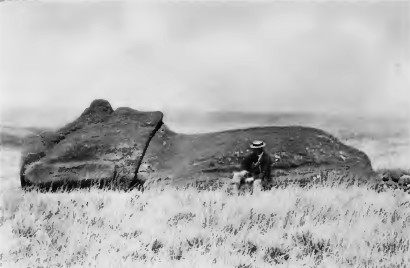
FIG. 75. — AN IMAGE
ON ITS BACK.
Unbroken; if erect,
would face westwards.
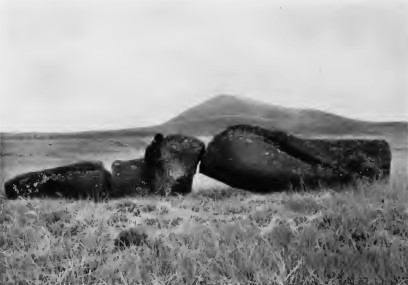
FIG. 76. — AN IMAGE
ON ITS FACE.
Showing by cleavage
and only partial fall
that it
has been erect and
faced westwards.
So far
the matter was sufficiently clear, but another problem was still
unsolved: if the
images were really being moved to their respective ahu all round the
coast, how
was it that, with very few exceptions, they were all found in the
neighbourhood
of Raraku? If also they were being moved, what was the method pursued,
for some
lay on their backs and some on their faces? With the hope of
elucidating this
great question of the means of transport, we dug under and near one or
two of
the single figures without achieving our end — nothing was found; but
the close
study which the work necessitated called attention to the fact that on
one of
them the lines of weathering could not have been made with the figure
in its
present horizontal attitude. The rain had evidently collected on the
head and
run down the back; it must therefore have stood for a considerable time
in a
vertical position. It was again a noticeable fact that, though some
single
figures are lying unbroken (fig. 75), others, like the large one on the
north
road, proved to be so shattered that no amount of normal disintegration
or
shifting of soil could account for their condition — they had obviously
fallen.
So wedded, however, were we at this time to the theory that they were
in course
of transport, that it was seriously considered whether they could have
been
moved in an upright position. The point was settled by finding one day
by the
side of the track, some two miles from the mountain, a partially buried
head.
This was excavated, and a statue found that had been originally set up
in a
hole and, later, undermined, causing it to fall forward. This was the
only
instance of an isolated figure where the burial had been to any depth,
but in
various other cases it was then seen that soil had been removed from
the base,
and one or two more of the figures had not quite fallen (fig. 76).
When the
whole number of the statues on the roads were in imagination
re-erected, it was
found that they had all originally stood with their backs to the hill.
Rano
Raraku was, therefore, approached by at least three magnificent
avenues, on
each of which the pilgrim was greeted at intervals by a stone giant
guarding
the way to the sacred mountain (map of roads). One of the ahu on the
south
coast, Hanga Paukura, has been approached by a similar avenue of five
statues
facing the visitor. These five images when first seen were a great
puzzle, as
some of them are so embedded in the earth that their backs are even
with the
levelled sward in front of the ahu; later there seemed little doubt
that, like
the two giants on the southeast side of Raraku, trenches had been dug
into
which they had fallen. Subsequently, a sixth statue was discovered, the
other
side of a modern
wall, weathered and worn away, but of Raraku stone and still upright.
This is
the only instance of an erect figure to be found elsewhere than on the
mountain
(fig. 77).
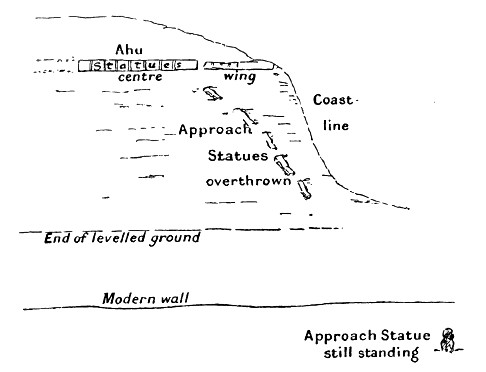
FIG. 77. — DIAGRAM
SHOWING CEREMONIAL AVENUE
OF AHU HANGA PAUKURA.
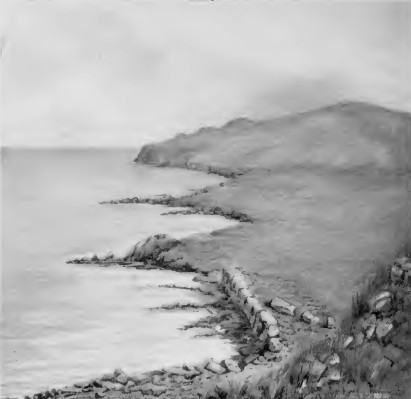
FIG. 78. — AHU PARO,
With image which
was the last to be
overthrown.
Foreground. —
Hillock, traditionally utilised
for placing the crown in position.
Distance. — Eastern Headland, with three
cones, from which Spanish sovereignty was proclaimed in 1770.
In
addition to the images which have stood in these processional roads,
there are,
excluding one or two figures near the mountain whose raison
d’être is somewhat doubtful, fourteen isolated statues in
various parts of the island, for whose position no certain reason could
be
found. Some of these may have belonged to inland ahu which have
disappeared, or
they may be solitary memorials to mark some particular spots, but the
greater
number appear to have stood near tracks of some sort. Some of these
last may
have been boundary stones, and in this class may perhaps fall the
smaller
statue now at the British Museum, which is a very inferior specimen.
According
to local information it stood almost half-way on the track leading from
Vinapu
to Mataveri along the bottom of Rano Kao; the hole from which it was
dug was
pointed out, and our informant declared that he remembered it standing,
and
that the people used to dance round it. The larger figure at the
British Museum
was in a unique position, which will be spoken of later.
No
statues were, therefore, found of which it could be said that they were
in
process of being removed, and the mode of transport remains a mystery.
An image
could be moved down from the quarry by means of banks of earth, and
though
requiring labour and skill, the process is not inconceivable.
Similarly, the
figures may have been, and probably were, erected on the terraces in
the same
way, being hauled up on an embankment of earth made higher than the
pedestals
and then dropped on them. Near Paro, the ahu where the last statue was
overthrown, there is a hillock, and tradition says that a causeway was
made
from it to the head of the tall figure which stood upon the ahu, and
along this
the hat was rolled (fig. 78) — a piece of lore which seems hardly
likely to
have been invented by a race having no connection with the statues. But
the
problem remains, how was the transport carried out along the level? The
weight
of some amounted to as much as 40 or 50 tons. It would simplify matters
very
much if there were any reason to suppose that the images were moved, as
was the
case with the hats, before being wrought, merely as cylinders of stone,
in
which case it would be possible to pass a rope under and over it, thus
parbuckling the stone or rolling it along, but the evidence is all to
the
contrary. There is no trace whatever of an unfinished image on or near
an ahu,
while, as we have seen, they are found at all stages in the quarry.
Presumably
rollers were employed, but there appears never to have been much wood,
or
material for cordage, in the island, and it is not easy to see how
sufficient
men could bring strength to bear on the block. Even if the ceremonial
roads
were used when possible, these fragile figures have been taken to many
distant
ahu, up hill and down dale, over rough and stony ground, where there is
no
trace of any road at all.
The
natives are sometimes prepared to state that the statues were thrown
down by
human means, they never have any doubt that they were moved by
supernatural
power. We were once inspecting an ahu built on a natural eminence, one
side was
sheer cliff, the other was a slope of 29 feet, as steep as a house
roof, near
the top a statue was lying. The most intelligent of our guides turned
to me
significantly. “Do you mean to tell me," he said, “that that was not
done
by mana?” The darkness is not
rendered less tantalising by the reflection that could centuries roll
away and
the old scenes be again enacted before us, the workers would doubtless
exclaim
in bewildered surprise at our ignorance, “But how could you do it any
other way?”
Besides
the ceremonial roads and their continuations, there are traces of an
altogether
different track which is said to run round the whole seaboard of the
island. It
is considered to be supernatural work, and is known as Ara Mahiva,
"ara" meaning road and "Mahiva" being the name of the
spirit or deity who made it. On the southern side it has been
obliterated in
making the present track — it was there termed the "path for carrying
fish";
but on the northern and western coasts, where for much of the way it
runs on
the top of high cliffs, such a use is out of the question. It can be
frequently
seen there like a long persistent furrow, and where its course has been
interrupted by erosion, no fresh track had been made further inland; it
terminates suddenly on the broken edge, and resumes its course on the
other
side. It is best seen in certain lights running up both the western and
southern edges of Rano Kao. Its extent and regularity appeared to
preclude the
idea of landslip. There is no reason to suppose that it is due to the
imported
livestock, and it has no connection with ahu, or the old native centres
of
population, yet to have been so worn by naked feet it must constantly
have been
used. This silent witness to a forgotten past is one of the most
mysterious and
impressive things on the island.
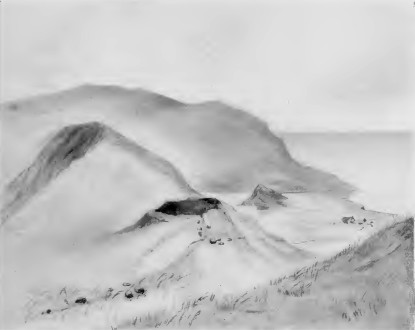
FIG 79. THE CRATER FROM WHICH THE HATS OF THE IMAGES
WERE HEWN, ON THE SIDE OF THE HILL PUNAPAU.
Rano Kao in the
distance.
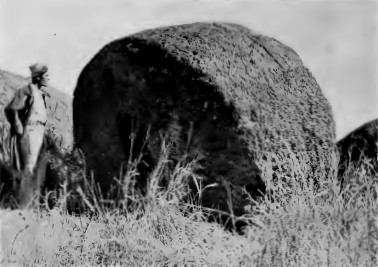
FIG. 80. AN UNFINISHED HAT NEAR THE QUARRY.
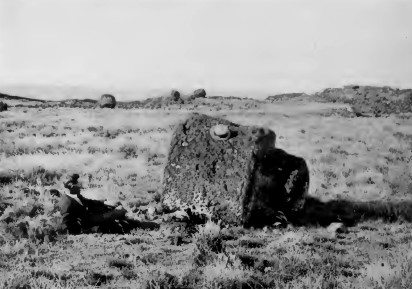
FIG. 81. A FINISHED HAT AT AHU HANGA O-ORNU; OTHERS IN
THE DISTANCE.
STONE CROWNS
OF THE IMAGES
Mention
must finally be made of the crowns or hats which adorned the figures on
the
ahu. Their full designation is said to be "Hau (hats) hiterau moai,"
but they are always alluded to merely as "hiterau" or "hitirau."
These
coverings for the head were cylindrical in form, the bottom being
slightly
hollowed out into an oval depression in order to fit on to the head of
the
image; the depression was not in the centre, but left a larger margin
in front,
so that the brim projected over the eyes of the figure, a fashion
common in
native head-dresses. They are said by the present inhabitants to have
been kept
in place by being wedged with white stones. The top was worked into a
boss or
knot. The material is a red volcanic tuff found in a small crater on
the side
of a larger volcano, generally known as Punapau, not far from Cook's
Bay (fig.
79). In the crater itself are the old quarries. A few half-buried hats
may be
seen there, and the path up to it, and for some hundreds of yards from
the foot
of the mountain, is strewn with them. They are at this stage simply
large cylinders,
from 4 feet to 8 feet high, from 6 feet to 9 feet across (fig. 80), and
they
were obviously conveyed to the ahu in this form and there carved into
shape
(fig. 81). An unwrought cylinder is still lying at a hundred yards from
the ahu
of Anakena. The finished hats are not more than 3 feet 10 inches to 6
feet in
height, with addition of 6 inches to 2 feet for the knob; the
measurement
across the crown is from about 5 feet 6 inches to 8 feet. The stone is
more
easily broken and cut than that of the statues, and while many crowns
survive,
many more have been smashed in falling or used as building materials.
It is a
noteworthy fact that the images on Raraku never had hats, nor have any
of the
isolated statues; they were confined to those on the ahu.
1 The sole
possible exception was probably due to some flaw in the stone.
2 The
farthest outstanding figure to the left in fig. 46
|

